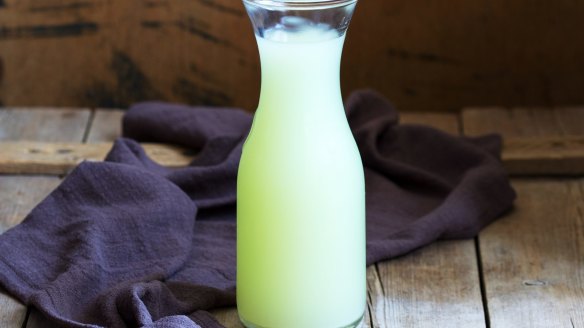Why you should never waste whey (and what to do with it)

What do I do with the whey left from making labneh? D.F. Princess
I love fresh labneh, which is natural yoghurt that has been drained of its whey. Thick, smooth, and full flavoured, you can use it in place of fresh cheese. You make it by taking a clean dish cloth or cheese cloth, then placing a litre or so of plain yoghurt in the middle and gathering up the cloth, tying it together with a rubber band. Next, suspend it over a container with a butcher's hook or wooden spoon that has been threaded under the rubber band, and let it drip. For every litre of yoghurt expect to retrieve about 500g of labneh and 500ml of whey. The whey is mostly water but is quite acidic, about 4.4 pH, which is the result of lactic acid bacteria eating lactose in the milk and producing lactic acid. This acid causes the proteins to coagulate into a very soft curd and watery acidic whey. Whey has been used in the past to feed animals such as pigs but in recent years has gained popularity as the base for smoothies and acidic soft drinks flavoured with sugar syrup and fruit puree. At home, whey is great for making pancakes. The lactic acid – when added to flour and baking powder – will help the dough rise. Use whey to marinate chicken or pork before barbecuing or roasting, to help tenderise the meat. Or try seasoning savoury dishes to add an acidic tang and a delicate dairy note.
I remember a trip to Spain where they served a cold vegetable soup that wasn't gazpacho but was made with loads of tomato. Do you know what it is called? D. Kerr
I, too, remember a trip to Spain and watching a beautiful young woman hand pound a gazpacho in a mortar with a pestle. She started with garlic, moving on to cucumber and tomatoes, then ending with green peppers and finishing the dish with salt, sherry vinegar, and fresh olive oil. Gazpacho comes from a family of cold soups made in a mortar with a pestle, the Neolithic version of a Thermomix, since Roman times. Bread, garlic, thyme, and water is probably one of the most basic soups. Another is made with skinned almonds, garlic, a little stale bread, olive oil, salt and water. Called ajo blanco, it is served chilled with chilled white grapes. On a hot day, it is more thirst-quenching than an ice-cold beer. In the ancient city of Cordoba, they make a cold tomato soup called salmorejo that is thickened with a good amount of stale bread. It is garnished and topped with chopped hard-boiled egg and chopped jamon. Being such a good season for tomatoes and other veg, this is the perfect time of the year to make gazpacho and salmorejo as well as ajo blanco.
Letters
Recently we were discussing string beans in this column, which prompted A. Robertson to write, "I love your Brain Food article in Good Food and I was particularly interested in the discussion about beans. I long ago found that an essential tool for preparing home-grown beans was a Krisk French-style bean slicer. This tool, invented in 1923 when beans had strings, slices beans into strips of even thickness so that no matter the shape and size of your home-grown beans, they all finish the same thickness for even cooking. A kitchen tool for the ages! You can see it at krisk.com.au."
Send your vexing culinary conundrums to brainfood@richardcornish.com.au or tweet to @foodcornish
Appears in these collections
- More:
- Food
- Brain food
